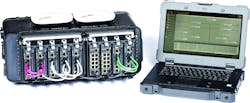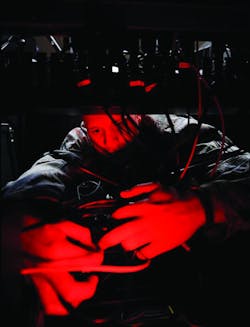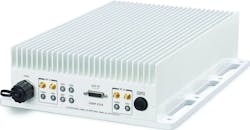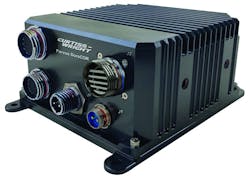NASHUA, N.H. - How do you make things smarter? That’s the question industry experts expect to answer as they develop small rugged mobile computers and network equipment for military vehicles and command posts.
Precision-guided munitions — or smart bombs — deployed during Operation Desert Storm 30 years ago made headlines, so-called intelligent munitions have roots even farther back, during the Vietnam War in 1967.
Today the U.S. armed forces only have increased the use of smart devices. The proliferation of connected systems has been enabled by the U.S. military embrace of the commercial off-the-shelf (COTS) revolution.
By using consumer-grade hardware in hardened enclosures, warfighters can repair, upgrade, and replace components at forward operating bases instead of relying on experts with a deep understanding of proprietary and secret technologies.
In addition to COTS, the embedded computing industry has used technology to pump even more power into systems by focusing on the size, weight, and power (SWaP) requirements of the components used. Now, warfighters have more power at their fingertips than ever before, and that trend is continuing.
That power is enabled by using the Internet of Things (IOT), machine learning, and artificial intelligence (AI).
Smarten up
“How do you make things smarter? How do you take everything that you possibly have and suddenly make it the smart version?” Jedynak asks. “We’re talking about man-machine teaming and artificial intelligence and technology.”
The Curtiss-Wright CTO says industry aims to bring small-form-factor computing to the edge by packing more power into ever-shrinking rugged enclosures and by bringing smarts to things like mortar shells.
“You’re not putting in the greatest computer ever, but you’re putting something that’s just good enough,” Jedynak says. “You’ve got cost pressures, you have environmental pressures, and you have all these different sorts of pressures.”
Open standards
When it comes to aerospace and defense embedded computing systems, open standards continue to hold a firm place in development and deployment. These include Sensor Open Systems Architecture (SOSA), VITA, Hardware Open Systems Technologies (HOST), and Modular Open Systems Approach (MOSA).
Justin Moll, vice president for marketing and sales at Pixus Technologies in Waterloo, Ontario, says there is a trend for small air transport racks (ATRs) to accommodate two to four OpenVPX slots in the 3U size. In addition, there often will be a single-board computer, a general-purpose graphics processing unit (GPGPU), or a digitizer.
“Increasingly, there will be VITA 67 or VITA 66 RF/Optical interfaces included,” Moll says. “There is also a lot of interest in user-programmable SDRs (software-defined radios) where any RF or radio system has the physical layer function performed in software rather than in fixed-function hardware. Engineers have been testing with products like NI’s X-series or N-series SDRs in the lab but are seeking field-testable and deployable versions in a rugged form factor.”
Moll continues, “The SOSA requirements are pushing higher speeds and higher-Wattage boards. Particularly with 3U OpenVPX backplanes, the cutouts for the VITA 66 and 67 interfaces can take away critical routing space. With Pixus’s expertise in high-performance OpenVPX backplane design, even in speeds beyond the capability of the 25G RT-3 connector, we’ve been able to solve many of the most complex high-speed routing challenges in the industry. Our experience allows us to suggest minor alterations to mitigate issues before the design even starts.”
Keeping cool
Putting more and more computing power into smaller, ruggedized enclosures means industry needs to find a way to keep everything adequately cooled. Pixus’s Moll says that he is seeing more 3U and 6U OpenVPX systems coming in at 2,000 to 2,500 Watts of power, with many boards coming in at the 175-to-225-Watt range.
“Fortunately, in semi-rugged or data center type of defense applications our standard enclosures can meet these challenges with dual 191 CFM hot swappable fans,” says Moll. “For MIL rugged, there are designs for Air-Flow-Through and Air-Flow-By solutions where the air is going directly over the fins of the boards’ heat sinks. This will help make airflow cooling more effective. Pixus and its partner is also developing a liquid cooled solution for 3U OpenVPX where the liquid flows through the enclosure sidewalls for enhanced cooling in the ATR enclosure format.”
Mike Southworth, senior product manager for Curtiss Wright, says embedded computing experts are integrating GPUs to accelerate computing at the edge.
So traditional graphics, engine and GPGPU being repurposed for artificial intelligence and machine learning is a significant trend within the system integrator community that serving the military today. Southworth says that the efficiency of the latest generation of processors and GPUs.
Late last year, Curtiss-Wright acquired Pacific Star Communications Inc. (PacStar) in Portland, Ore., PacStar’s Chief Technology Officer Charlie Kawasaki says he agrees with his colleague Mike Southworth on processor efficiency driving development of vehicle- or key fob-based computers and servers.
“Improved efficiency that allows us to employ more technology at the edge of the network helps offset the military concern of a contested spectrum,” Kawasaki says. “Our deployed organizations don’t necessarily have to rely on the compute resources at large facilities or in the cloud, but have the resources available to them out in the field.
“So even if their connectivity is disconnected, they still can do communications. They can still take advantage of these new machine-learning technologies that can help do things like improve decision-making or reduce the number of people that need to be in harm’s way. One of the side effects of this improved efficiency is that we can shrink the size, weight and power required to support these kinds of compute workloads. And one of the things that military organizations are looking at now is to dispense with what used to be a large tent-based command post kind of cities and enable mobility.”
Adapting traditional data-center technology for the battlefield plays a factor, Kawasaki says. “So take what used to be sort of data-center-style equipment and get it mounted on communications vehicles and command post vehicles that can now drive around and offer commanders with options for mobility and that improve survivability ... of the way that we conduct warfighting. And so, one of the things we’re doing with this shrinking compute resource is you’re making that possible.”
In the field
Last month officials of Systel Inc., a rugged computer designer in Sugar Land, Texas, announced the Kite-Strike rugged supercomputer line, which integrates the NVIDIA AGX Xavier system-on-module. Kite-Strike is built for deployment in harsh environments to enable real-time AI and deep learning capabilities, and provide centralized sensor ingest and data fusion support.
“Kite-Strike represents a massive leap forward in edge computing, providing data center performance in an ultra-compact, fully rugged computer,” says AneeshKite-Strike features dense I/O capability and supports several configurations including video capture and encode and high-bandwidth networking. Kite-Strike is engineered to environmental specifications including the ability to operating in temperatures from -40 to 70 degrees Celsius, as well to MIL-STD-810H, 1275E, 704F, 461E, and DO-160G.
Curtiss-Wright also announced a Jetson AGX Xavier system-on-module rugged super computer with its Parvus DuraCOR AGX-Xavier SWaP-optimized and small form factor system.
Featuring military-grade ruggedization in a fanless IP67 aluminum enclosure with military-grade circular connectors and a power supply that meets military specifications.
Curtiss-Wright officials say the Parvus-DuraCOR AGX-Xavier is suitable for military vehicles, avionics mission computing, sensor integration, unmanned vehicles, electronic warfare (EW) and military targeting.
The DuraCOR AGX-Xavier supports high-speed network connectivity with 10-Gigabit Ethernet optical interfaces, high-speed I/O connectivity with USB 3.1 interfaces, and high-resolution video outputs with HDMI 2.0 and DisplayPort interfaces. In addition to its base system I/O, the system can be modified with mini-PCI Express and PCI Express104 expansion card options. The unit features native eMMC Flash memory and supports high-speed NVMe-based M.2 solid-state drives and removable U.2 NVMe Flash SSD storage.
Star bright
PacStar’s 453 NVIDIA GPGPU enhanced server module is suitable for tactical vehicle-mounted and forward-operating-base virtualization and hosting.
The PacStar 453 is based on the PacStar 451 platform that features Intel Xeon D processing, with 128 gigabytes of RAM, 16 terabytes of data storage, and 10 Gigabit Ethernet SFP+ ports, combining high-power, general-purpose computing with a PCI Express connected NVIDIA GPGPU with 896 CUDA cores.
PacStar also offers its scalable Secure Wireless Command Post (SWCP) to provide, as the name suggests, secure access to Wi-Fi forward bases. The SWCP was recognized by Military & Aerospace Electronics as the recipient of Platinum-level recognition in 2020.
The PacStar SWCP battlefield networking system is a small, modular communications package that enables warfighters to transmit classified and unclassified information securely in tactical settings while using their Wi-Fi and LTE-enabled commercial smartphones and tablet computers.
PacStar SWCP has proven transformation for military requirements because it marries a modular communications package of hardware and software that reduces the management burden for tactical high-security communications.
At the same time, PacStar shrunk the software and hardware package down to where it could be deployed practically in tactical environments.
The SWCP can help deployed warfighters transmit classified and unclassified information securely in tactical settings while using their Wi-Fi and LTE-enabled commercial smart phones and tablet computers.
Secure wireless tactical eliminates the need for miles of cabling and air-conditioned tents. Instead, warfighters can mount the units on tactical vehicles and pick-up and quickly move as the mission requires.








